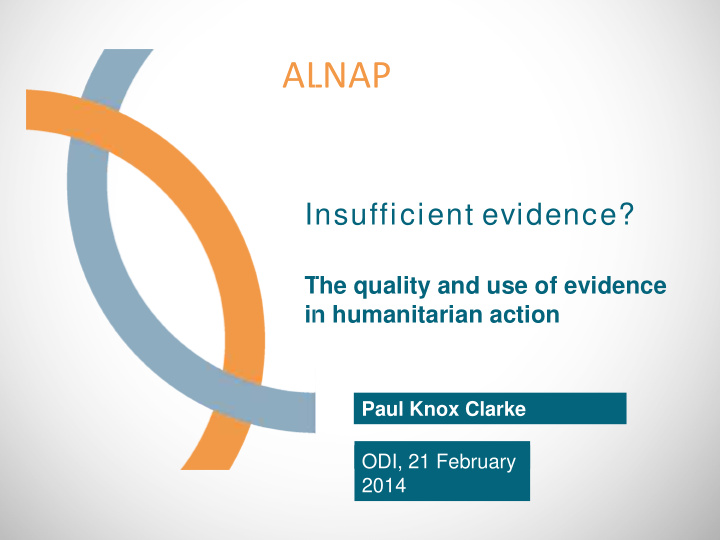



ALNAP Insufficient evidence? The quality and use of evidence in humanitarian action Paul Knox Clarke ODI, 21 February 2014
Cont ent What is evidence? Why does it matter? How can we judge evidence? How good is the evidence currently available? How can we use it better? What’s ALNAP doing about it?
What do we mean by EVIDENCE? Why does it matter?
Failure to generate and use Information that helps prove or evidence makes disprove a specific proposition. humanitarian action: • less effective • less ethical • less accountable
EVI DENCE Generally relates to either… PROPOSITION B PROPOSITION A That a situation of That certain actions humanitarian need will be – or were – exists, which requires effective in addressing external assistance. humanitarian needs.
How can we judge EVI DENCE? Accuracy Representativeness Relevance Attribution Generalisability Clarity around concepts and methods
How good is EVI DENCE? E arly warning Challenge: relevant indicators E valuations Assessments Challenge: Challenge: Weak in Accuracy? attribution, Representative? generalisability Monitoring Challenge: Focus on outputs (relevance) Short time series
What can we DO? • Work with academics to improve (quantitative and qualitative) methodology • Invest relative to potential impact • Collaborate : identify gaps, share results, critique findings • Build evidence over time • Address systematic exclusion of crisis affected people
The use of evidence is inconsistent We should consider what we mean by ‘use’
H o w c a n w e u s e EVI DENCE b e t t e r ?
Individuals & organisations • Ensure evidence is accessible and easily presented . • Make evidence available before decisions are made. • Disseminate evidence and arguments through different media to different groups. Decision makers & humanitarian organisations • Ensure there are explicit requirements for evidence in the process. • Incentivise use of evidence in decision-making . • Allow programmes to change on basis of new evidence.
What is doing about it? • Improve quality and use of evaluations by: • Introducing guidance • Continuing use of communities of practice • Update and refine ALNAP’s resource library . • Continue to experiment with varied approaches in our research . • Work to better understand decision making and avoid risk.
T h a n k y o u . Fo r m o r e i n f o r m a t i o n p l e a s e vi s i t : w w w .a l n a p .o r g / o u r w o r k / e vi d e n c e
More recommend